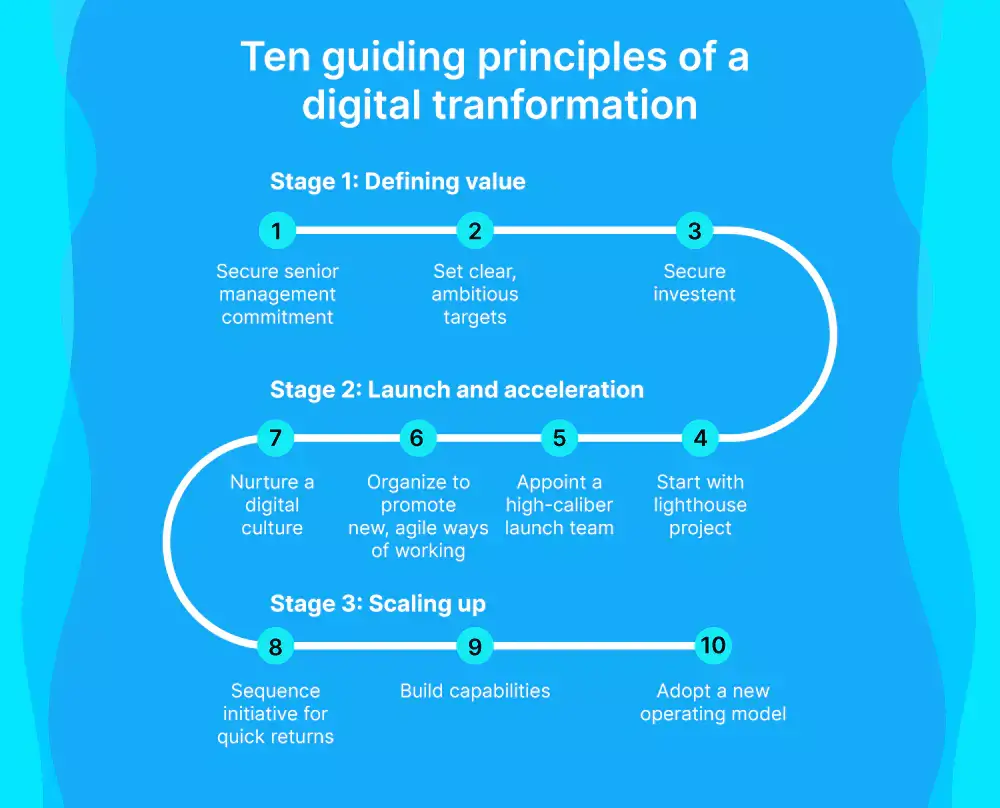In the world of businesses, the term Digital Transformation is commonly used, but guidance on how to actually implement a successful process tends to be overly complex. A well-defined roadmap for digital transformation serves as the guiding compass for organizations seeking to navigate this complex terrain successfully. In this article, we will explore a 10-step guidance to embark on the digital journey, providing organizations with the insights and tools needed to set off on a transformative adventure that can reshape their future. Let’s find out!
Table of Contents
What is Digital Transformation?
Digital transformation refers to the process of integrating new digital technologies or modifying the existing solution to fundamentally change and improve various aspects of an organization’s operation. This process involves many strategic initiatives that can take many forms. From transferring files and documents to the cloud, automating repetitive tasks to free up team members’ time, to connecting and integrating new tools into your current solution.

However, digital transformation is not just about adopting new technology; it’s about rethinking how an organization operates, delivers value, and interacts with its stakeholders. Successful digital transformation leads to increased competitiveness, cost savings, better customer experiences, and the ability to adapt to rapidly changing market conditions.
For a smooth and effective digital transformation, the contribution of a solid digital strategy cannot be taken for granted. This is the point at which your strategy becomes a comprehensive plan or road map, which outlines your future decision-making.
What Is a Digital Transformation Roadmap?
A digital transformation roadmap is a strategic plan that outlines the steps and milestones an organization needs to achieve in its journey toward digital transformation. It serves as a guiding document that helps an organization navigate the complexities of implementing digital technologies and evolving its processes and culture to become more digitally mature.
Your business’s strategy plays a critical role in defining your roadmap. To map out a complete transformation process, you’ll need to consider the following points:
- Whether digital transformation can resolve your organization’s current issues
- How your business will be digitally transformed
- What resources you will require and which capabilities you will pursue during your digital transformation journey
- How much time you’ll invest in completing your journey
- What are the milestones for progress tracking within your digital roadmap
A well-defined digital transformation roadmap provides clarity, alignment, and a structured approach to executing the transformation journey. It helps ensure that everyone in your organization understands the goals and steps involved in becoming more digitally mature, which is essential for successful digital transformation. Additionally, it enables your businesses to adapt to changing circumstances and technologies as you progress through your digital journey.
10 Steps of a Roadmap for Digital Transformation
There are many definitions for digital transformation roadmap available out there. In this following part, we’ll offer the ten guiding principles of a digital transformation introduced by McKinsey & Company to provide the most comprehensive guidance for your businesses.

These 10 steps are distributed for 3 phases of the digital transformation process, from defining value, launch and acceleration, to scaling up,
Stage 1: Defining value
Before taking on the digital transformation, you’ll need to make sure that this is placed at the core of your business strategy. Leaders and managers need to be ready for heavyweight management commitment, are willing to make significant investments, and set clear, ambitious targets.
Secure leadership commitment
The first crucial step in any digital transformation roadmap is to secure an unwavering commitment from top leadership. Given that CEO commitment is positioned as the solution to any major challenge within the business, this sets the tone for the entire organization and ensures that digital transformation is a strategic priority.
Leaders cannot simply authorize a digital transformation; he or she must communicate a vision of what must be accomplished and why in order to demonstrate that digital is an unquestionable priority, hold other leaders accountable, and make it more difficult to revert course. They should serve as role models for embracing digital technologies and ways of working.
Set clear, ambitious targets
To achieve a cost-effective and optimal digital transformation, investments must be tied to specific, aspirational goals. What do you wish to achieve? How do your objectives currently stand within your organization? Your digital transformation should begin with the company’s current vision, mission, and core values. Setting clear goals from the outset prevents procrastination and backsliding during difficult times. It also provides useful information for determining which initiatives to pursue for maximum impact.
Targets should be set for each source of value creation, as well as for new ways of working and the required new competencies. Additionally, they should be aligned with the organization’s overall strategy and reflect measurable results. The frequency of releases, the proportion of processes that will be automated, the proportion of transactions that will be migrated from one channel to another, the proportion of new code that will be tested automatically, the level of personalization that will be attained, and the number of campaigns that will be executed each month are examples of targets.
Secure investment
Digital transformation requires significant investment in technology, talent, and process improvement. This investment is likely to result in lower profits in the beginning, however, its absence poses a significant threat to long-term profits. Securing the necessary funding is critical to execute the roadmap effectively. This involves building a compelling business case that demonstrates the return on investment (ROI) for each initiative and gaining approval from stakeholders.
Stage 2: Launch and acceleration
While it is simple to initiate change initiatives, keeping them active is a difficult task. Companies frequently provide funding and resources for multiple initiatives. However, when the ideas fail to improve business performance, executives easily postpone the process because they incorrectly conclude that there is no urgency as the market is not ready for change.
To achieve success in early efforts, businesses should carefully select which initiatives to launch and allocate adequate resources and investments. A high-caliber launch team, organizational structure consideration, and digital culture are some practices you should implement at this stage.
Start with lighthouse projects
Instead of attempting a full-scale transformation all at once, begin with lighthouse projects. These are small-scale initiatives that demonstrate the value of digital transformation and serve as proof of concept. They provide quick wins with minimal effort, build confidence among employees, and showcase the benefits of broader transformation efforts.
Appoint a high-caliber launch team
Having a high-caliber launch team is the next essential step to getting your digital transformation off the ground. There are several ways to achieve this. You can leverage the role of a Chief Digital Officer (CDO) in coordinating a transformation. He or she is able to ensure the right technology and skills are in place and monitor progress against targets.
However, as the role of CDO has proved to be temporary, another option is to assemble a digital transformation team. Key personnel included in this team are designers, data scientists, scrum masters, and developers. Designers are in charge of contemplating customers’ unmet needs and informing the creation of experiences, products, and services; scrum masters are responsible for facilitating agile development; and developers are in charge of IT-related issues. They must be able to integrate new technologies without interfering with existing or legacy technology.

Due to the rivalry for digital talent and the advantage technology businesses have in attracting it, finding the best talent is a significant difficulty. To meet the expectations of ambitious recruits, companies might need to modify their typical value proposition to provide empowerment in their work on high-impact digital initiatives.
People leadership skills are also essential, as transformation is not just about reinventing products and disrupting value chains. Combining young talent with seasoned professionals and harmonizing old and new is part of the solution. Digitally aware employees hired from outside the sector may succeed in developing a digital-direct, eCommerce business, but they are frequently ill-equipped to modernize the current channels, where enormous prospects for value creation lie. Because it is challenging to find someone well-versed in field sales and digital, traditional agency distribution is found to lack innovation.
Organize to promote new, agile ways of working
The organizational structure of any business is key to a successful launch. Traditional hierarchical structures can impede digital transformation. Implement cross-functional teams, promote experimentation, and give employees the authority to take responsibility for their work. This shift in structure and mindset is crucial for adapting to the rapidly changing digital landscape.
A suggested practice is to establish an independent digital unit within the organization. This can encourage new ways of working that are crucial for digital success, such as agile product development, test-and-learn methods that accelerate progress while maintaining a customer-centric focus, and cross-functional teams that pool different types of expertise.
Nurture a digital culture
We’ve touched upon getting leadership and senior managers’ buy-in for the initial launch, as well as making digital ways of working and thinking becoming the default mode for new recruits with digital skills. Now it’s time to nurture these methods, making sure that the rest of your companies understand the vision.
Cultivating a digital culture is fundamental to success. Firstly, you should ensure that employees understand the value of your digital transformation journey and the new technologies you’ve implemented. Discuss the primary objectives, and the steps needed to achieve them. This will assist in reassuring teams that these new technologies will simplify their work and reduce errors and frustrations. Foster an environment where employees are encouraged to embrace digital tools, continuously learn, collaborate with others, and share insights. Celebrate innovation and recognize employees who contribute to digital transformation efforts. This can contribute to a favorable environment to foster effective change management in pursuing digital strategies.
Stage 3: Scaling up
This is the stage where every digital initiative and progress are under control. Hence, it is time to boost the transformation and scale everything up. The next essential step for businesses is the careful sequencing of subsequent initiatives. It is also necessary to pay close attention to the expansion of capabilities. Finally, to reap the full benefits of digital transformation, a completely new operating model will eventually be required.
Sequence initiatives for quick returns
The key to building scale quickly is to think about how to order things to get quick returns. When entering the transformation journey, often a company’s approach is to let a thousand flowers bloom. However, this causes a considerable waste of scarce resources and pressure on margins when competition rises. Hence, it is important to pursue a manageable number of digital initiatives to maintain the performance of the core business while cultivating future growth opportunities.
Initiatives that are strategically important, able to deliver quick returns, and reduce complexity are the ones that need to be prioritized. This not only builds momentum but also helps fund subsequent phases of the transformation.

Tracking returns is necessary to make sure that all available value is exploited. It aids in the identification of successful initiatives that deliver the anticipated financial benefits, allowing managers to focus more on their development. Letting go of what does not work also matters. The board and top team can leverage the return tracking to determine which initiatives are ineffective and eliminate them as soon as possible.
Build capabilities
To scale up digital initiatives, it is now evident that businesses must invest in more than just digital technologies. Further investment can be made in the modernization of core operating platforms to provide customers with a seamless digital experience.
The result of a digital transformation is the establishment of an agile operating model across the entire organization; therefore, internal training is of the utmost importance. Educated programs should be provided for the entire organization in order to provide business leaders with an understanding of the strategic value of digital transformation and to equip employees with the skills required to thrive in new business processes. This investment in human capital is essential for the digital transformation’s long-term success.
Adopt a new operating model
No matter what structures your businesses choose initially, there will come a time when only a major organizational redesign will do. As your businesses enter the digital world, the traditional matrix structures may hamper your possibility to thrive. In the digital age where customer demand and trends change at a fast pace, companies have to reinvent the way they work on the fly. An inability to connect all parts of the organization, which is caused by the diverse functional silos within the organization, significantly slow down the change process.
Consider adopting a new operating model that aligns with the digital age. This may involve redefinition of processes, adoption of automation and data-driven decision-making, and optimization of customer experiences across digital channels. Replace the current rigid matrix with a more adaptable one that prioritizes the agile working method. A flexible and adaptable operating model will allow the organization to respond rapidly to shifting market dynamics and develop effective coordination across the entire organization in order to successfully enter the digital world.
The benefits of a digital transformation roadmap
Saving costs for digital transformation projects
A well-structured digital transformation roadmap optimizes resource allocation and expense management. With a clear outline of digital initiatives as well as project scope and returns tracking, businesses can easily determine which initiative is performing effectively to keep on further development. Consequently, issues such as cost overruns and duplication of efforts are mitigated. Businesses can also pinpoint areas to implement cost-cutting measures. This disciplined approach to resource management ensures that digital transformation projects stay on budget, preventing financial strain while achieving desired outcomes, thereby making it a more cost-effective method for businesses to embark on this journey.
Better customer engagement & experience
By developing a details digital transformation plan, you can easily develop digital initiatives that align with customer-centric objectives. In this way, along with the stage of examining the most effective initiatives, your business is enabled to determine the appropriate technology to better comprehend and serve customers. This may include personalized marketing, streamlined online purchasing processes, improved customer service via chatbots, and real-time feedback mechanisms.

Moreover, as businesses adopt a more agile organizational structure that best aligns with digital strategies, they are more flexible in adapting to customer-changing demand. Along with the integration of digital technologies and the application of the best-fit digital initiatives, companies are able to gather valuable customer data, personalize interactions, and offer seamless omnichannel experiences, which ultimately result in increased customer loyalty.
Improved productivity & collaboration
A well-defined digital transformation roadmap facilitates the streamlining of business processes and workflows. With clear steps for each stage of the process, you’ll know where your business stands on the journey, allowing you to map its future path. You can also use this information to evaluate the performance of each step, determining which are performing effectively and which are not, enabling you to eliminate redundant tasks and concentrate on initiatives with a greater potential to generate more value.
A roadmap also guides the adoption of tools and technologies that enable seamless collaboration within your business operations in a systematic manner. The breakdown of small steps ensures effective integrations into the business’s workflow. These solutions, including cloud-based collaboration platforms, project management software, and communication tools, have great potential to effectively enhance team collaboration, break down silos, and facilitate remote work, ultimately leading to an increase in overall productivity.
More accurate insights
Digital transformation often involves the collection and analysis of vast amounts of data. A well-structured roadmap ensures that data analytics and business intelligence initiatives are aligned with the strategic goals of your businesses. As a result, organizations can harness data to gain more accurate insights into customer behavior, market trends, and operational performance. This, in turn, enables smarter decision-making, targeted marketing, and proactive issue resolution.
Increased profits
The ultimate goals of digital transformation are business expansion and profitability. Understanding the digital transformation roadmap enables you to prioritize initiatives with the greatest potential to affect the bottom line of your businesses. In addition, as you gain access to more comprehensive, contextual, and accurate data, it improves your business’s decision-making across the board. All of the benefits above that are brought to you by a roadmap for digital transformation will ultimately result in an increase in profits for your businesses.
Faster time to market
A digital transformation roadmap promotes an agile way of working and streamlines the operation process. This helps accelerate product and service delivery. A roadmap sequences initiatives in a way that allows for faster time to market, enabling organizations to respond more swiftly to changing customer demands and market trends. Accordingly, businesses are empowered to seize new opportunities easily and mitigate risks along the way.
Marketplace differentiation
Understanding and executing a digital transformation roadmap comes with the establishment of a significant competitive advantage. As there is an increasing number of newcomers into the digital world, businesses that are proactive in their transformation efforts are better positioned to lead in their respective markets.
The adoption of a clear roadmap for digital transformation helps accelerate this process. Businesses are enabled to introduce innovative products and services, respond to customer needs faster, and attract top talent with a focus on cutting-edge technologies. This competitive edge allows businesses to stay ahead of the curve, which eventually translates into increased market share and revenue growth.
3 Tips for Successfully Deploying Your Digital Transformation Roadmap
Turn your employees into change ambassadors
Employees are at the heart of any successful digital transformation effort. To ensure the smooth execution of your roadmap, it’s vital to turn your workforce into change ambassadors. Getting your teams involved in the transformation is the first step, but keeping them engaged and motivated throughout the process is the determining factor for your success.
You should engage your employees from the early step in your digital transformation roadmap. Communicate the vision and goals of the process clearly. Encourage their active participation, feedback, and ideas. Provide training and resources to equip them with the skills needed to thrive in the evolving digital landscape. Recognize and celebrate their contributions and successes. When employees understand and support the transformation, they become champions who pose a positive influence on their peers, driving adoption and minimizing resistance throughout the journey.
Set a fast transformation pace
In the rapidly evolving digital environment of today, agility is critical. It’s essential to set a relatively fast transformation pace to keep up with market changes and emerging technologies. The initial few months of your transformation strategy are crucial and frequently set the tone for the entire process. You will continually test out new technologies to determine which ones are most effective. Managing expectations and communicating goals, milestones, KPIs, and dates will aid in navigating this rapid transformation.

However, this pace should also be realistic, considering your organization’s capacity and resources. Agile methodologies provide support by allowing for incremental progress and adjustments along the way. Frequent reviews and course corrections ensure that you stay on track and adapt to new challenges and opportunities swiftly. Embrace a mindset of continuous improvement, where each phase of the roadmap builds upon the previous one, leading to increasingly effective and efficient digital operations.
Share small wins early and often
Building momentum and maintaining stakeholder support is crucial for the success of your digital transformation. One effective way to achieve this is by sharing small wins early and often. Identify quick wins within your roadmap that demonstrate the tangible benefits of your digital initiatives. These could be improvements in customer engagement, cost savings, productivity gains, or any other measurable successes. Communicate these wins regularly to employees, leadership, and other relevant stakeholders. This not only celebrates achievements but also reinforces the value of the transformation effort and keeps enthusiasm high. Small wins can generate positive energy and encourage ongoing commitment to the larger digital transformation goals.
It is important to note that you should not allow these early achievements to make you complacent. Keep the momentum going. Evaluate those results, and reinvest them, thus adding more value to your whole transformation process.
Conclusion
Digital transformation is a long process that requires great effort from the whole organization. Hence, it is essential for you and your entire organization to keep the momentum, be patient, and stay committed to the whole process to see it succeed. The roadmap for digital transformation that includes all facets of your organization is the optimal solution to address this issue. By securing leadership commitment, setting clear targets, and nurturing a digital culture, organizations can embark on a journey of continuous improvement and adaptation. It’s a journey where each step brings new opportunities, challenges, and rewards, ultimately leading to a future where organizations are not just surviving but thriving in the digital world.
Completing the digital transformation roadmap is the first step for you to officially enter the digital world. To delve deeper into this journey with more tactics to stay ahead in this crowded marketplace, subscribe to our newsletter for more valuable news and articles on this topic. We’re pleased to be your number-one supporter for your success in the digital era.











